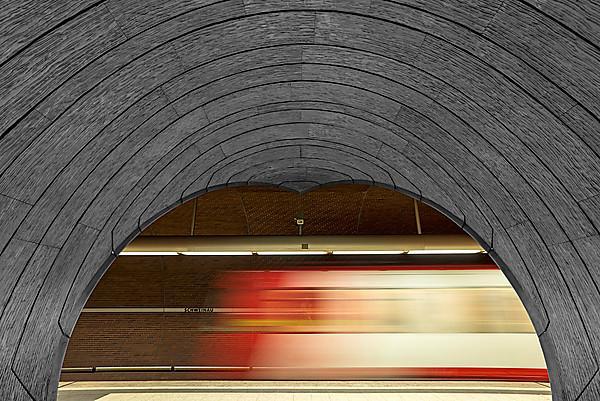How to save hundreds of thousands of euros in just three seconds

The rail transport sector is the biggest energy consumer in Germany. Scientists in Nuremberg are working on ways to make train timetables more energy-efficient.
In Nuremberg, the difference is a matter of seconds. Three seconds, to be precise. That’s the tiny increase in travel time between two subway stations that the Nuremberg rapid transit system would have to take on board in return for major cost and energy savings.
“Barely perceptible increases in journey times can have a hugely beneficial impact on energy consumption,” says mathematician Andreas Bärmann, who leads the project “Advanced driver assistance systems in rail transport” at the ADA Lovelace Center for Analytics, Data and Applications in Nuremberg.
The Center is an initiative of the Fraunhofer Institute for Integrated Circuits IIS in cooperation with Friedrich-Alexander-Universität Erlangen- Nürnberg (FAU) and Ludwig-Maximilian-Universität München (LMU). Officially opened in December 2019, this center of excellence for data analytics and AI in industry actually started work the previous year. Bärmann – a postdoctoral researcher at FAU – and his team members Patrick Gemander and Lukas Hager work on behalf of transit provider Verkehrs-Aktiengesellschaft Nürnberg (VAG) to find ways of organizing rapid transit systems in a more energyefficient manner.
Synchronized arrival and departure times
Operating energy is a key cost factor for rail transport providers, says Bärmann – hence VAG’s interest in the project. To find the best ways of reducing power consumption and thereby cutting energy costs, the ADA experts incorporated various factors in their calculations. They discovered that optimizing the timetable is a good place to start. Reducing the number of trains that depart simultaneously has the effect of lowering peak loads in the rail power grid. Peak loads have a significant impact on the price the company pays for its power.
Another important lever is improving the coordination of train arrivals and departures. When a train brakes, it generates lectricity that is fed back into the system. This regenerative energy can be used by a different train to accelerate, but only if it is leaving at the same time the other train is braking. “Otherwise the energy is lost,” says Bärmann.
The third factor that influences energy consumption is how the trains are driven. For example, do they always accelerate to maximum speed and only brake when they reach the station? Or do they travel at a slightly lower speed and then gradually coast to a stop over a longer stretch of track? The researchers at the ADA Lovelace Center calculated that, under optimum conditions, VAG could cut its energy consumption by up to ten percent by exploiting all these options. That would slash the company’s electricity bill by up to 500,000 euros a year. Passengers wouldn’t notice any significant difference, says Bärmann, noting that the slightly longer travel times between stations would only affect journey times by plus or minus 15 seconds.
The ADA experts had already calculated the huge savings potential of rail timetable optimization in a previous project. With rail transport consuming more energy than any other sector in Germany, it’s clearly an important issue. Passenger and freight trains use 11 billion kilowatt hours of power a year, as much as the city of Berlin. One ADA Lovelace study calculated that Deutsche Bahn could decrease its passenger train power consumption by 38 megawatts a year simply by optimizing timetables and peak loads in the rail power grid. That would reduce the company’s energy bill by five million euros a year while also benefiting the environment.
Two years into the project
Yet organizing a train timetable to maximize energy efficiency is a mammoth task, says Bärmann. For example, even running just 4 trains between 3 stops with a choice of 7 times for each departure, you end up with 14 billion possible timetables. Fortunately, mathematical optimization – Bärmann’s area of specialization – can be used to reduce the extremely large number of theoretical possibilities to the ones that actually make sense in practice. This required them to program a special algorithm, says Bärmann, which was something of a challenge. It took the Nuremberg-based team of researchers a total of two years to complete that task.
The next step that Bärmann’s team and transit provider VAG are planning is to expand the areas in which the model can be applied. The idea is to develop algorithms for driver assistance systems in order to control train journeys in real time. “We need AI methods that are capable of responding to unexpected incidents and disruptions,” says Bärmann. This is far from easy, he adds – but it’s the only way to exploit potential savings in day-to-day operation. Nuremberg already has computer-controlled, driverless subway trains, which makes it ideal for their purposes.
The algorithms developed at the ADA Lovelace Center could also be applied in other areas, says Professor Alexander Martin, director of Fraunhofer IIS and head of the ADA Lovelace Center. “Many companies know next to nothing about the type, quantity or quality of data they have at their disposal. They don’t know what data they need for a specific application – or indeed what applications they could optimize using the data they have.” The research work carried out by the ADA Lovelace Center could help them answer these questions.
Truck platooning is one area where he believes this methods could be successfully applied. This involves linking two or more trucks in a convoy, all controlled by the first vehicle via radio – much like a train, but on the highway. Other areas that could potentially be improved with the help of AI include production processes and energy-efficient machine operation.
This highlights what makes the ADA Lovelace Center so special, says Professor Martin: “We use real-world industry use cases as examples. They provide the basis for developing and enhancing our expertise, methods and processes.”